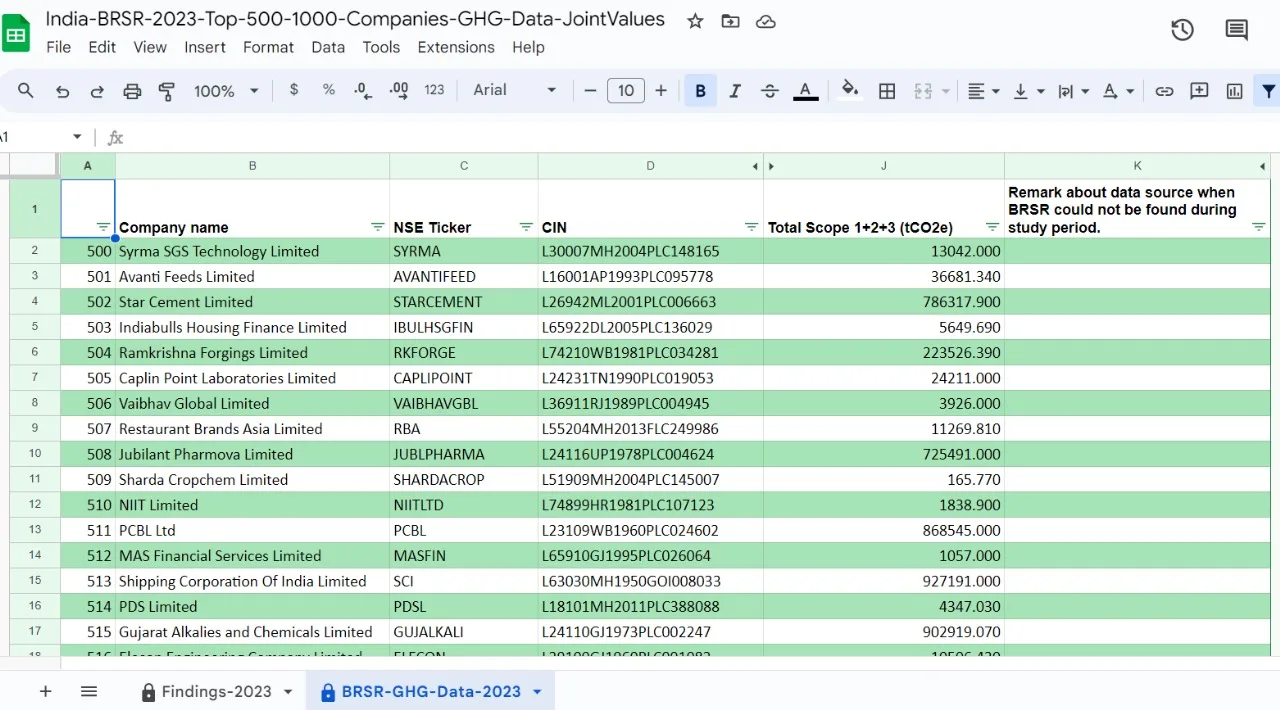
Global Regulatory Actions for Reliable ESG Ratings: SEBI Leads the Charge in India
Introduction:
This article delves into the increasingly important role of Environmental, Social, and Governance (ESG) ratings as a tool for investors and stakeholders to incorporate sustainability considerations into their decision-making. This comprehensive analysis explores the issues plaguing ESG ratings, provides an overview of recent global initiatives aimed at regulating ESG rating agencies, and examines the groundbreaking regulations implemented by the Securities and Exchange Board of India (SEBI).
Growing Numbers of ESG Rating Data Providers:
The rise in global assets under management (AUM) linked to ESG factors has fueled the growth of ESG rating data providers. Currently, there are approximately 150 ESG data providers, each developing their own methodologies and assessment criteria. The Principles for Responsible Investment (PRI) has experienced a surge in signatories, representing a staggering US$121 trillion of AUM. Bloomberg’s research predicts that ESG-related AUM will reach an astonishing US$53 trillion by 2025, comprising one-third of global investments. This exponential growth in ESG ratings and data providers is directly correlated with the expansion of ESG-linked AUM worldwide.
The Complex Landscape of ESG Ratings:
ESG rating agencies exhibit significant variations in their purpose, methodologies, and sources of information. Some agencies focus exclusively on a company’s internal management of ESG risks and opportunities, while others consider the broader impact on society and the environment. Additionally, the information used by these agencies ranges from publicly available data to direct engagement with companies and stakeholders. The output formats employed by rating agencies also differ significantly, ranging from numerical values to letter grades or qualitative descriptions. Moreover, the opportunities for dialogue and engagement between companies and rating agencies span a wide spectrum, from secretive operations to open processes that allow companies to review and provide feedback on draft reports. Notably, there has been a lack of avenues for legal challenges against ESG rating agencies, which sets them apart from credit rating agencies. While some jurisdictions have recognized the duty of care of credit agencies towards investors, similar regulations have yet to be adopted for ESG rating agencies. The absence of standardization and the potential for disparate conclusions among rating agencies regarding the same entity or product have raised concerns among users of ESG rating reports. Studies have shown that the correlation between prominent ESG rating agencies is relatively low compared to credit rating agencies, which further exacerbates the challenge of effectively comparing and evaluating companies.
Low Correlations Challenge in ESG Ratings:
ESG ratings and credit ratings share the commonality of being data-driven assessments provided by third-party entities. However, ESG ratings exhibit low correlations (average 0.54) between scores assigned to the same company by different rating agencies, compared to the higher correlations seen in the highly regulated field of credit ratings, as this is also found by data based study entitled “Aggregate Confusion: The Divergence of ESG Ratings” by Berg, Kölbel, and Rigobon (2022). The complexity of ESG ratings stems from their coverage of three distinct pillars: environmental, social, and governance. Aggregating these pillars into a single ESG score is intricate due to the differing materiality and standardization of issues across each pillar. Furthermore, the long-term horizon of ESG ratings adds to the challenge of accurately assessing the qualitative parameters being evaluated. In contrast, credit ratings primarily evaluate the creditworthiness of an entity or financial instrument based on a ranking system. Credit ratings can be assigned to both issuers and individual financial instruments, while ESG ratings are typically assigned at the issuer level, reflecting the overall characteristics of the company rather than specific activities. However, recent guidelines from the International Capital Market Association (ICMA) and other agencies have expanded the scope of ESG ratings to include financial instruments as well.
Another significant distinction lies in the payment model. Credit ratings are often paid for by issuers, which has been criticized for contributing to rating inflation. On the other hand, ESG ratings often follow an investor pays model, where investors pay a fee to access the ratings and underlying information. However, there has been a recent shift in some ESG rating agencies adopting the issuer-paid model, similar to credit ratings. Additionally, assessing the accuracy of credit ratings can be done based on the default or non-default of the instrument or issuer. In contrast, there is currently no straightforward method to perform ex-post assessments of the quality of ESG ratings, making accuracy evaluation more complex and challenging.
The dilemma of different ESG scores of the same issuer:
ESG rating represents a score given to an entity based on its sustainability performance compared to a set of weighted indicators. However, the lack of standardization in methodologies among ESG rating agencies contributes to the low correlation between ratings. Berg, Kölbel, and Rigobon (2022) identify scope, measurement, and weighting as the key factors causing divergence among ratings. Measurement and scope differences account for the majority of the variance. To achieve rating convergence, standardized quantitative disclosure is crucial. When companies disclose their ESG activities and performances using comparable indicators, rating agencies are more likely to incorporate these indicators into their evaluation processes, leading to more consistent ratings. Standardized quantitative disclosure, guided by regulatory or non-governmental organization standards, facilitates convergence by aligning evaluation systems and enabling easier comparisons between companies.
In different studies, the lack of standardization in ESG rating methodologies has resulted in divergent ratings. However, standardized quantitative disclosure plays a vital role in promoting convergence among rating agencies. By using commonly accepted indicators and following reporting instruments or standards, agencies can narrow the differences in their evaluation systems. This allows for more consistent ratings and facilitates horizontal comparisons between companies. Ultimately, the adoption of standardized disclosure practices will contribute to greater transparency and comparability in the ESG rating ecosystem.
Global Initiatives to Control ESG Rating Providers:
The increasing importance of ESG ratings in the sustainable finance ecosystem has prompted regulatory bodies worldwide to address concerns regarding standardization, transparency, and the reliability of ratings. Several global initiatives have been undertaken to shape the future of ESG ratings:
- International Organization of Securities Commissions (IOSCO): In November 2021, IOSCO examined the field of ESG ratings and data, identifying areas that required improvement and providing recommendations. These recommendations focused on enhancing the reliability of raw ESG data, transparency in methodologies and data products, managing conflicts of interest, and improving communication between ESG rating providers and entities. IOSCO emphasized the importance of collaboration between regulators and market participants to implement these recommendations effectively.
- European Commission’s (EC) Initiative: The EC initiated a targeted consultation in April 2022 to gather insights on the functioning of the ESG ratings market and the consideration of ESG factors in credit ratings within the European Union. This consultation aimed to align with the sustainable finance strategy adopted in July 2021 and assess the incorporation of ESG risks in creditworthiness assessments. In June 2023, the EC proposed comprehensive measures to strengthen the EU sustainable finance framework, including expanding the EU Taxonomy and introducing new regulations for ESG rating providers. The proposed regulations aim to increase transparency in the market for sustainable investments, enhance the reliability and transparency of ESG ratings, and ensure market integrity and investor protection.
- Financial Services Agency (FSA) Japan’s Initiative: In December 2022, the FSA in Japan issued The Code of Conduct for ESG Evaluation and Data Providers, aligning with the report released by IOSCO. While the code is voluntary, organizations are encouraged to publicly declare their support for the code and either comply with its principles and guidelines or provide explanations for non-compliance. The code emphasizes transparency, disclosure, and good governance practices for ESG rating providers.
- UK Government’s Initiative: In March 2023, the UK government initiated a consultation on the future regulatory regime for ESG ratings providers. Recognizing the financial sector’s significance in supporting the UK’s commitment to achieving net-zero emissions, the government aims to establish a credible ESG ratings market. The consultation seeks to strike a balance between proportionality, clarity, innovation, and good practice standards. The UK government emphasizes alignment with international standards and collaboration with its partners. Feedback from stakeholders, including ESG ratings providers, users, trade associations, and consumer groups, will inform the development of specific firm rules by the Financial Conduct Authority (FCA).
- International Capital Market Association (ICMA)’s Initiative: On July 5, 2023, ICMA, in collaboration with the International Regulatory Strategy Group (IRSG), released a voluntary code of conduct for ESG ratings and data product providers. This code aims to enhance consistency, transparency, and accountability in the financial services industry, instilling market confidence in the integrity of ESG ratings and data products through improved systems, processes, and controls. The code outlines key best practice principles, including ensuring good governance with transparent and effective conflict management, implementing robust systems and controls for high-quality and consistent products, managing conflicts of interest to safeguard independence and objectivity, and prioritizing transparency through public disclosure of methodologies and processes.
SEBI’s Trailblazing Regulations in India:
On July 3, 2023, SEBI announced the Securities and Exchange Board of India (Credit Rating Agencies) (Amendment) Regulations, 2023, which represents a significant step forward in regulating ESG rating agencies. The new regulations bring ESG rating agencies under the purview of regulations that were previously applicable only to credit rating providers. The regulations specifically focus on ESG rating providers and aim to enhance transparency, governance, and the prevention of conflicts of interest in the ESG rating industry.
The amended regulations come into force immediately upon publication in the Official Gazette and introduce a new chapter titled “ESG Rating Providers” within the existing Securities and Exchange Board of India (Credit Rating Agencies) Regulations, 1999. These regulations apply to ESG rating providers listed in the Fourth Schedule, with certain chapters continuing to apply to all credit rating agencies.
ESG ratings are defined as rating products that provide opinions about an issuer’s or a security’s ESG profile, characteristics, exposure to ESG risk, governance risk, social risk, climatic or environmental risks, or impact on society, climate, and the environment. These ratings are assigned using a defined ranking system of rating categories, irrespective of explicit labelling as “ESG ratings.”
Under the new regulations, ESG rating providers must obtain a certificate from SEBI to operate in the industry. Existing providers have a grace period of six months to obtain the certificate or until the disposal of their application, whichever comes first. To be eligible for certification, applicants must be incorporated as a company under the Companies Act, 2013, with ESG rating as their main objective stated in the Memorandum of Association.
The regulations also outline specific criteria for the registration of ESG rating providers. The promoter of the applicant must adhere to a number of requirements, including being subject to oversight by financial sector regulators like SEBI, the Reserve Bank of India, the Insurance Regulatory and Development Authority of India, or the Pension Fund Regulatory and Development Authority. Alternatively, the promoter can be a foreign ESG rating provider incorporated in a Financial Action Task Force (FATF) member jurisdiction with at least five years of experience in providing ESG ratings. The applicant must maintain a minimum shareholding of 26% by the promoter for a period of five years from the date of registration.
To ensure transparency, ESG rating providers are required to maintain a website where they disclose their ESG ratings, scores on environmental, social, and governance parameters, and other parameters forming part of the ESG rating. They must also provide a hyperlink to the methodology for assigning an ESG rating. The rating providers are expected to prioritize public disclosure and transparency, disclose their rating methodologies, and provide category-wise weightage of environmental, social, and governance factors in their ratings.
ESG rating providers are prohibited from undertaking activities, offering products or services, or providing consulting or advisory services related to environmental, social, and governance aspects, except for ESG rating services and activities incidental to such services.
Additionally, the regulations emphasize the need to prevent conflicts of interest within ESG rating providers. Providers are required to identify, disclose, and mitigate potential conflicts of interest; establish policies and codes of conduct for dealing with conflicts of interest, and ensure the independence and objectivity of their decision-making processes.
SEBI has also prescribed a Code of Conduct for ESG rating providers, which includes guidelines on integrity, professionalism, objectivity, and disclosure. ESG rating providers are expected to adhere to high standards of integrity, observe dignity and fairness in their conduct, fulfil their obligations promptly and ethically, and exercise due diligence and independent professional judgment. They must maintain records to support their decisions, adopt rigorous and consistent rating standards, and avoid unfair competition. The code of conduct further highlights the importance of protecting confidential information, reporting non-compliance, and maintaining proper internal operations and employee conduct.
Looking Forward:
The initiatives undertaken by IOSCO, the European Commission, FSA Japan, the UK government, and ICMA highlight the growing emphasis on consistent practices and transparency in the ESG ratings market. SEBI’s pioneering regulations in India represent a significant leap forward, bringing ESG rating providers under regulatory oversight and setting clear guidelines for transparency, governance, and conflict of interest prevention.
Regulators and market participants are recognizing the importance of standardizing ratings while addressing conflicts of interest and the accountability of the rating providers by bringing some of their skin into the game. For example, SEBI has set a threshold for the total net worth and paid-up capital of the company to come into the business of ESG rating. However, directly regulating the methodologies of ESG rating providers is not, and in fact should not be, the underpinning idea of regulatory bodies, as that can kill innovation and development in ESG ratings.
As the world moves towards sustainable and responsible investing, the regulation of ESG ratings plays a crucial role in ensuring reliable and credible information for investors and stakeholders, including issuers.
Reference:
“Bloomberg,” n.d. https://www.bloomberg.com/professional/blog/esg-assets-may-hit-53-trillion-by-2025-a-third-of-global-aum/.
Berg, F., Kölbel, J. F., & Rigobon, R. (2022). Aggregate Confusion: The Divergence of ESG Ratings. Review of Finance, 26(6), 1315-1344. https://doi.org/10.1093/rof/rfac033
ESG Ratings: Don’t Throw the Baby out with the Bath Water | MIT Sloan, February 23, 2023. https://mitsloan.mit.edu/ideas-made-to-matter/esg-ratings-dont-throw-baby-out-bath-water.
Finalization of “the Code of Conduct for ESG Evaluation and Data Providers.” “Finalization of the Code of Conduct for ESG Evaluation and Data Providers,” n.d. https://www.fsa.go.jp/en/news/2022/20221215/20221215.html
Finance. “Finance-2022-Esg-Ratings,” n.d. https://finance.ec.europa.eu/regulation-and-supervision/consultations/finance-2022-esg-ratings_en
GOV.UK. “Future Regulatory Regime for Environmental, Social, and Governance (ESG) Ratings Providers,” March 30, 2023. https://www.gov.uk/government/consultations/future-regulatory-regime-for-environmental-social-and-governance-esg-ratings-providers
PRI Signatory Update: October to December 2022, n.d. Accessed 2023. Https://Www.Unpri.Org/Download?Ac=18057 ,
Rate the Raters 2023: ESG Ratings at a Crossroads, n.d. Accessed March 2023.Https://Www.Sustainability.Com/Thinking/Rate-the-Raters-2023/
SEBI | Securities and Exchange Board of India (Credit Rating Agencies) (Amendment) Regulations, 2023. “SEBI | Securities and Exchange Board of India (Credit Rating Agencies) (Amendment) Regulations, 2023,” n.d. https://www.sebi.gov.in/legal/regulations/jul-2023/securities-and-exchange-board-of-india-credit-rating-agencies-amendment-regulations-2023_73451.html
The Board of the International Organization of Securities Commissions. “Environmental, Social and Governance (ESG) Ratings and Data Products Providers: Final Report.” Https://Www.Iosco.Org/Library/Pubdocs/Pdf/IOSCOPD690.Pdf , November 2021.









